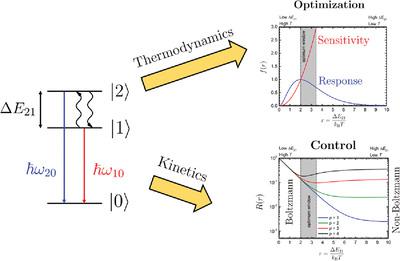当前位置:
X-MOL 学术
›
Adv. Theory Simul.
›
论文详情
Our official English website, www.x-mol.net, welcomes your feedback! (Note: you will need to create a separate account there.)
A Theoretical Framework for Ratiometric Single Ion Luminescent Thermometers—Thermodynamic and Kinetic Guidelines for Optimized Performance
Advanced Theory and Simulations ( IF 3.3 ) Pub Date : 2020-10-12 , DOI: 10.1002/adts.202000176 Markus Suta 1 , Andries Meijerink 1
Advanced Theory and Simulations ( IF 3.3 ) Pub Date : 2020-10-12 , DOI: 10.1002/adts.202000176 Markus Suta 1 , Andries Meijerink 1
Affiliation

|
Luminescence (nano)thermometry is an increasingly important field for remote temperature sensing with high spatial resolution. Most typically, ratiometric sensing of the luminescence emission intensities of two thermally coupled emissive states based on a Boltzmann equilibrium is used to detect the local temperature. Dependent on the temperature range and preferred spectral window, various choices for potential candidates appear possible. Despite extensive experimental research in the field, a universal theory covering the basics of luminescence thermometry is virtually nonexistent. In this manuscript, a general theoretical framework of single ion luminescent thermometers is presented that offers simple, user‐friendly guidelines for both the choice of an appropriate emitter and respective embedding host material for optimum temperature sensing. The results show that the optimum performance (thermal response and sensitivity) around T0 is realized for an energy gap ∆E21 between thermally coupled levels between 2kBT0 and 3.41kBT0. Analysis of the temperature‐dependent excited state kinetics shows that host lattices in which ∆E21 can be bridged by one or two phonons are preferred over hosts in which higher order phonon processes are required. Such a framework is relevant for both a fundamental understanding of luminescent thermometers but also the targeted design of novel and superior luminescent (nano)thermometers.
中文翻译:

比例单离子发光温度计的理论框架-优化性能的热力学和动力学准则
发光(纳米)热测量法对于具有高空间分辨率的远程温度感测是一个日益重要的领域。最典型地,基于玻耳兹曼平衡的两个热耦合发射态的发光发射强度的比例感测被用于检测局部温度。根据温度范围和首选的光谱窗口,可能会出现各种可能的候选选择。尽管在该领域进行了广泛的实验研究,但几乎不存在涵盖发光测温法基础的通用理论。在本手稿中,介绍了单离子发光温度计的一般理论框架,为选择合适的发射器和相应的嵌入基质材料以实现最佳温度感测提供了简单易用的指南。Ť 0被实现用于能量间隙Δ ë 21 2之间热耦合电平之间ķ乙Ť 0和3.41 ķ乙Ť 0。对与温度相关的激发态动力学的分析表明,与其中需要更高阶声子过程的主体相比,其中ΔE 21可以被一个或两个声子桥接的主体晶格是首选的。这样的框架不仅对发光温度计有基本的了解,而且对于新颖和高级的发光(纳米)温度计的目标设计也很重要。
更新日期:2020-12-07
中文翻译:

比例单离子发光温度计的理论框架-优化性能的热力学和动力学准则
发光(纳米)热测量法对于具有高空间分辨率的远程温度感测是一个日益重要的领域。最典型地,基于玻耳兹曼平衡的两个热耦合发射态的发光发射强度的比例感测被用于检测局部温度。根据温度范围和首选的光谱窗口,可能会出现各种可能的候选选择。尽管在该领域进行了广泛的实验研究,但几乎不存在涵盖发光测温法基础的通用理论。在本手稿中,介绍了单离子发光温度计的一般理论框架,为选择合适的发射器和相应的嵌入基质材料以实现最佳温度感测提供了简单易用的指南。Ť 0被实现用于能量间隙Δ ë 21 2之间热耦合电平之间ķ乙Ť 0和3.41 ķ乙Ť 0。对与温度相关的激发态动力学的分析表明,与其中需要更高阶声子过程的主体相比,其中ΔE 21可以被一个或两个声子桥接的主体晶格是首选的。这样的框架不仅对发光温度计有基本的了解,而且对于新颖和高级的发光(纳米)温度计的目标设计也很重要。



























 京公网安备 11010802027423号
京公网安备 11010802027423号